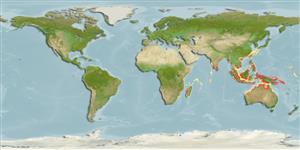Common names from other countries
Classification / Names / Names
Nombres comunes | Sinónimos | Catalog of Fishes (gen., sp.) | ITIS | CoL | WoRMS
Environment: milieu / climate zone / depth range / distribution range
Ecología
; rango de profundidad 7 - 90 m (Ref. 3175). Tropical
Distribución
Países | Áreas FAO | Ecosistemas | Ocurrencias, apariciones | Introducciones
Indo-West Pacific.
Length at first maturity / Tamaño / Peso / Age
Maturity: Lm ? range ? - ? cm Max length : 8.3 cm CW macho / no sexado; (Ref. 343); 7 cm CW (female)
Carapace rounded, much wider than long; surface convex, with dense pubescence; 6 anterolateral teeth. Spine present on outer margin of dactylus of last walking leg. Light brown with bright pink fingers.
Maximum size of male from Ref. 3175. Omnivorous, feeds on sea stars (Asteroidea). Carries sponges and colonial tunicates on back for camouflage (Ref. 343).
Life cycle and mating behavior
Madurez | Reproducción | Puesta | Huevos | Fecundidad | Larva
Members of the order Decapoda are mostly gonochoric. Mating behavior: Precopulatory courtship ritual is common (through olfactory and tactile cues); usually indirect sperm transfer.
Ng, P.K.L. 1998. (Ref. 343)
IUCN Red List Status (Ref. 130435)
CITES status (Ref. 108899)
Not Evaluated
Not Evaluated
Threat to humans
Harmless
Human uses
Pesquerías: escaso valor comercial
| FishSource |
Herramientas
Más información
Age/SizeCrecimientoLength-weightLength-lengthMorfologíaLarvaAbundancia
Fuentes de Internet
Estimates based on models
Preferred temperature
(Ref.
115969): 26.1 - 29.1, mean 28.2 (based on 1406 cells).
Vulnerability
Low vulnerability (10 of 100).
Price category
Unknown.
